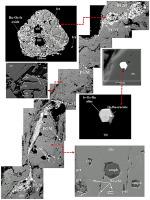Geoscience Frontiers ( IF 8.5 ) Pub Date : 2020-09-06 , DOI: 10.1016/j.gsf.2020.08.005 George Tsoupas , Maria Economou-Eliopoulos

|
Extremely abundant PGE-minerals (PGM) hosted in chromitites from the Veria ophiolite complex in Macedonia (N. Greece) may be unique among ophiolite complexes. This study focuses on differences between the low- and high-PGE chromitites. New textural, mineralogical and geochemical constraints from those ores are presented, aiming to define factors controlling the PGE enrichment in a supra subduction environment, in the light of post-magmatic processes. The whole ore analyses for mmajor and trace elements indicated an unusually high-IPGE content (up to 25 ppm) and higher Fe, Ca, Mn, Zn and V contents in high-PGE compared to low-PGE in massive chromitites. The wide compositional variation of chromite, even in the same polished section, the occurrence of very fine PGM (less than 20 μm) as inclusions within chromite and extremely large (>1000 μm), angular or fine-grained PGM aggregates ones within a matrix of highly fragmented chromite - Cr-garnet matrix, may indicate crystallization/recrystallization of chromite from more than one precursor phases. Laurite (RuS2) is very limited, occurring as remnants surrounding by Ru–Os–Ir oxides/hydroxides, of a wide compositional variation. Irarsite occurs as euhedral crystals up to 200 μm, surrounding by chromite, as anhedral exsolutions 1–200 μm within laurite, or creating segregates with platarsite and relics of (Ru, Pt, Rh, Os) sulfarsenides. Platinum–Ru–Rh–Pd-minerals occur commonly as relatively fine-grained assemblages, up to 50 μm, along with irarsite and other relics of (Ru, Pt, Rh, Os) sulfarsenides. Pt-alloys show a variation ranging from tetraferroplatinum to Pt–Ir–Fe–Ni alloys. The presence of laurite relics in large IPGM, awaruite, heazlewoodite, and carbon-bearing material reflecting a super-reducing environment, and the transformation of primary PGM into Os–Ir–Ru-alloys and oxides/hydroxides in association with Fe-chromite and Fe3+-bearing garnet (andradite-uvarovite solid-solution series) may reflect changes of the redox conditions from reducing to oxidizing. The relatively high Na content in hydrous mineral inclusions within high-PGE chromitites suggest a hydrous mantle source and provide the possibility for estimation of the P (average 3.0 kbar) and T (average 874 °C), indicating formation at a shallow mantle environment.
中文翻译:

超俯冲带中PGM的转变:维里亚(希腊)坡状铬铁矿的地球化学和矿物学约束
在蛇麻岩复合物中,来自马其顿(希腊北部)的维里亚蛇绿岩复合物中铬铁矿中所含的极其丰富的PGE矿物(PGM)可能是独特的。这项研究着眼于低PGE和高PGE铬铁矿之间的差异。提出了来自这些矿石的新的质地,矿物学和地球化学约束,旨在根据后岩浆作用过程确定在超俯冲环境中控制PGE富集的因素。整体矿石分析中的mmajor和微量元素表明,与块状铬铁矿中的低PGE相比,高PGE中的IPGE含量异常高(高达25 ppm),并且Fe,Ca,Mn,Zn和V含量更高。铬铁矿的成分变化很大,即使在相同的抛光区域中,也会发生非常细的PGM(小于20μm)作为铬铁矿内部的夹杂物并且非常大(> 1000μm),在高度碎片化的铬铁矿基质(铬石榴石基质)中,角状或细颗粒的PGM聚集体可能表明铬铁矿从多个前体相中结晶/重结晶。月桂石(RuS2)是非常有限的,由于残留物被Ru–Os–Ir氧化物/氢氧化物包围,因此组成变化很大。锡石发生在高达200μm的真面状晶体中,被亚铁矿包围,在月桂酸盐中以1-200μm的无面状析出,或与白铁矿和(Ru,Pt,Rh,Os)硫化砷遗迹形成隔离。铂-钌-铑-钯-矿物质通常以相对细颗粒的组合形式存在,最大可达50μm,与铁矾石和(Ru,Pt,Rh,Os)硫化砷的其他遗迹一起出现。铂合金显示出从四铁铂到Pt–Ir–Fe–Ni合金的变化。大型IPGM,铁榴石,heazlewoodite和含碳材料中的月桂石遗迹反映了一种超还原性环境,以及将初级PGM转变为Os-Ir-Ru合金以及与铁铬铁矿和铁氧化物结合的氧化物/氢氧化物铁含3+的石榴石(锰铁矿-微锰矿固溶体系列)可能反映了氧化还原条件从还原到氧化的变化。高PGE铬铁矿中水合矿物包裹体中的Na含量相对较高,表明水合地幔来源,并为估算P(平均3.0 kbar)和T(平均874°C)提供了可能性,表明在浅地幔中形成环境。











































 京公网安备 11010802027423号
京公网安备 11010802027423号